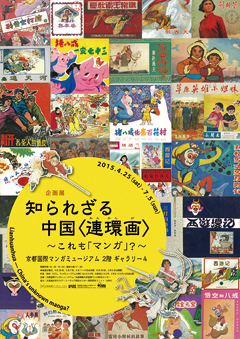Liánhuánhuà:
China's unknown manga?

Have you heard of liánhuánhuà? They are probably not well known in Japan, but liánhuánhuà are pocket-sized Chinese publications that are basically composed of one image and a paragraph of text on each page. They emerged in China in the early 20th century and as they could be read cheaply, they were popular with many people, from children to adults. They came to occupy a prominent position in Chinese mass-media, and liánhuánhuà now give us a glimpse of people's lives and the social climate in China at the time.
The Kyoto International Manga Museum presents an exhibition that introduces the multifaceted nature of liánhuánhuà and investigates the common ground between liánhuánhuà and the similar popular visual media of manga.
| Period |
April 25 - July 5, 2015 10am - 6pm (Admission to the museum is until 5:30pm) Closed : Wednesdays (Except 4/1, 29, 5/6), 4/30, 5/7, 6/1~4 |
| Venue | Kyoto International Manga Museum, 2F Gallery 4 |
| Fee | Free * However, a General Admission ticket to the Museum is required. |
Organization : Kyoto International Manga Museum,
Kyoto Seika University International Manga Research Center
Cooperation : Hokkaido University Slavic-Eurasian Research Center,
Eurasia Unit for Border Research, Japan (UBRJ)
Exhibition Content
This exhibition gathers a collection of over 300 items covering the themes outlined below, on loan from supervising editor of the exhibition and Chinese culture researcher Takeda Masaya (Hokkaido University, Graduate School of Letters, Professor). Furthermore, some material has been included for reference from the exhibition 'Images of China' held at The Hokkaido University Museum in 2011.


What are Liánhuánhuà?
Basic information about liánhuánhuà exhibiting works depicting classical Chinese literature such as Journey to the West, Water Margin, and Romance of the Three Kingdoms.
Liánhuánhuà and the Chinese People
Introducing the breadth of variation in liánhuánhuà, this corner explores its use for political propaganda during the Chinese cultural revolution, and its strength as an entertainment media for the adaptation of films and foreign novels, etc.
Let's Read Liánhuánhuà
Taken as the archetypical liánhuánhuà, the work Monkey subdues the White-Bone Demon by Zhao Hongben and Qian Xiaodai is exhibited using large panels so it can be read, appended with Japanese translation. Additionally, the diversity of liánhuánhuà expression is introduced by works such as Illustrated Journey to the West (1945), an artwork by pioneering decorative artist Zhang Guangyu, which differs from traditional liánhuánhuà forms of expression, incorporating Western and Eastern painting characteristics.
From Liánhuánhuà to New Manhua
Covering topics such as the manga style influenced 'new manhua' which emerged from the 1190s, we consider the changing environment surrounding liánhuánhuà and the situation of modern Chinese manhua.
Related Events
Gallery Talk
Jiao Fan (Kyoto Seika University, Manga Postgraduate Course Doctoral Program), who has been involved with the exhibition, will hold a gallery talk.
| Date |
April 25, 2015 11:00am / 2:30pm May 30, 2015 11:00am * Approximately 40 minutes per session. |
| Venue | Kyoto International Manga Museum, 2F Gallery 4 |
| Fee | Free * However, a General Admission ticket to the Museum is required. |
| Capacity | 40 people (on a first come basis) |
| How to participate | No pre-registration required |
Academic Symposium
The Many Faces of Liánhuánhuà:
Exploring common ground with other genres.
Featuring a keynote speech by supervising editor of the exhibition Takeda Masaya, this symposium will examine the common ground from various points of view of liánhuánhuà and other genres including manga, children's culture, literature, and drama.
*This symposium will be held in Japanese.
| Date | May 30, 2015 1:00pm - 5:30pm |
| Venue | Kyoto International Manga Museum 3F Research room 1 |
| Fee | Free * However, a General Admission ticket to the Museum is required. |
| Capacity | 50 people (on a first come basis) |
| How to participate | No pre-registration required |
| Timetable / Speakers | 13:00-13:10 Opening remarks |
|
Part I Presentation and Discussion
|
|
15:50-16:05 Break |
|
|
PartⅡ Lecture and Talk 16:05-16:35 Lecture Takeda Masaya (Hokkaido University) |
|
| Organization |
Japan Society for the Promotion of Science Grants-in-Aid for Scientific Research Foundation Research (A) "Reading the Record of a Hundred Years of Intra-East Asian Conflict and Cooperation through Research in Audio-Visual Materials" (Representative: Kishi Toshihiko) Japan Society for the Promotion of Science Grants-in-Aid for Scientific Research Foundation Research (C) "A Study of Chinese Period Children's Magazines: Axis between the activities of the Commercial Press and children's motifs" (Representative: Sasaki Mutsumi) |
About Liánhuánhuà
Liánhuánhuà are pocket-sized publications that emerged in China in the early 20th century. Generally they feature one image and a paragraph of explanatory text on each page. Common themes included classical Chinese literature such as Journey to the West, Romance of the Three Kingdoms, and Water Margin, but they also depicted adaptations of other media that communicated through both visuals and language such as theatrical plays, films, and anime, etc. Liánhuánhuà fulfilled a prominent role as a form of popular entertainment, enjoyed by both children and adults. They were mainly sold in bookstores, but could also be borrowed for a low cost from rental libraries called 'Children's Bookstands' (Xiǎo rén shū tān) where many children would sit, absorbed in reading. They reached their golden age in the 1960s, and were also published in great numbers during the Chinese cultural revolution, but from the mid-1980s the popularity of liánhuánhuà began to gradually decline due to the rise of manga influenced 'new manhua'. These days, they are once again attracting attention and are prized by collectors as valued antiques.









